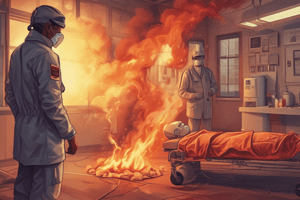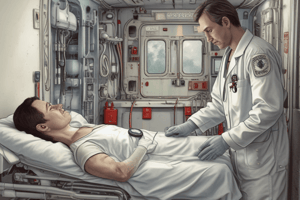Podcast
Questions and Answers
What does the term 'deformity' refer to?
What does the term 'deformity' refer to?
- A bruise or discoloration
- Being misshapen (correct)
- An abnormal increase in mobility
- A deep cut
What are 'contusions' commonly known as?
What are 'contusions' commonly known as?
- Scrapes
- Bruises (correct)
- Burns
- Cuts
What is the definition of 'abrasion'?
What is the definition of 'abrasion'?
- A bruise
- A scrape or scratch (correct)
- A deep cut
- A puncture wound
What does 'punctures/penetrations' refer to?
What does 'punctures/penetrations' refer to?
What are 'burns' classified as?
What are 'burns' classified as?
What does 'tenderness' indicate?
What does 'tenderness' indicate?
What is the definition of 'laceration'?
What is the definition of 'laceration'?
What does 'swelling' indicate?
What does 'swelling' indicate?
What does 'instability' refer to in a medical context?
What does 'instability' refer to in a medical context?
What does the term 'crepitus' describe?
What does the term 'crepitus' describe?
Flashcards are hidden until you start studying
Study Notes
DCAP BTLS TIC Overview
- DCAP BTLS TIC is a mnemonic used for assessing traumatic injuries in emergency medicine.
- Each letter represents specific types of injuries or observations to look for during evaluation.
Deformity
- Characterized by misshapen body parts or structures.
- Suggestive of underlying fractures or dislocations.
Contusions
- Commonly known as bruises that indicate localized bleeding under the skin.
- Present as visible discoloration and can indicate the severity of trauma.
Abrasions
- Refers to scratches or scrapes on the skin's surface.
- Often results from friction against rough surfaces, indicating potential for infection.
Punctures/Penetrations
- Wounds created by sharp objects piercing the skin.
- These types of injuries risk infection and require careful management.
Burns
- Can be caused by heat, chemicals, or electricity, categorized by degree of severity (1st, 2nd, 3rd).
- Treatment depends on the depth and extent of the burn.
Tenderness
- Refers to pain or discomfort when an area is touched or palpated.
- Can indicate underlying injury to bones, muscles, or organs.
Lacerations
- Deep cuts typically caused by sharp objects.
- Require proper cleansing and sometimes suturing to prevent infection.
Swelling
- Indicates accumulation of fluid in tissues, often resulting from inflammation or injury.
- Can cause pain and restrict movement, serving as a sign of trauma.
TIC (Tenderness, Instability, Crepitus)
- Tenderness: Pain upon touch, a critical indicator of injury.
- Instability: Abnormal mobility in joints or bones, signaling potential fractures or dislocations.
- Crepitus: A popping sound due to trapped air in tissues or joints, indicating serious underlying issues.
Summary of Terms
- Deformity: Misshapen structures indicating injury.
- Contusion: Bruise showing discoloration, reflective of localized trauma.
- Abrasion: Surface scrape prone to infection.
- Laceration: Deep cut needing careful treatment.
- Instability: Increased joint mobility hinting at fractures.
- Crepitus: Popping sounds from air in tissues or joints.
Studying That Suits You
Use AI to generate personalized quizzes and flashcards to suit your learning preferences.




